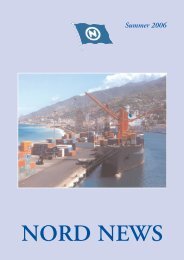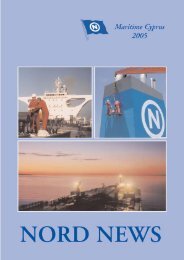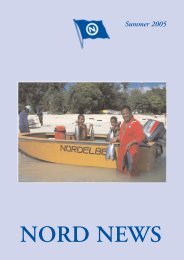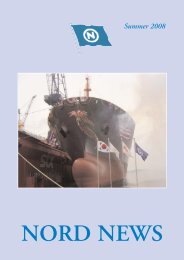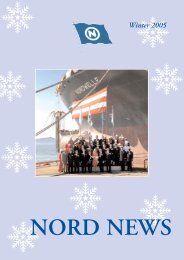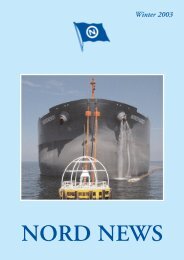WINTER 2007.qxd
WINTER 2007.qxd
WINTER 2007.qxd
You also want an ePaper? Increase the reach of your titles
YUMPU automatically turns print PDFs into web optimized ePapers that Google loves.
4 NORD NEWS Winter 2007<br />
The Great Barrier Reef is the "only" single "living organism" in the<br />
world visible from the Earth's orbit. It was elected as a World<br />
Heritage site in 1981 by UNESCO (United Nations Educational,<br />
Scientific and Cultural Organization). It is more than 2,000 km<br />
long and it is located on the East Coast of Australia. It contains the<br />
world's largest collection of coral reefs being 400 different types,<br />
1,500 fish species and 4,000 types of mollusc.<br />
Corals make up the various reefs. These are the basis for the great variety of sea<br />
and animal life in the Reef. Coral consists of individual coral polyps or living<br />
creatures which live inside a shell and are joined together to form forests of<br />
coloured coral. All these corals joined together have formed the Great Barrier<br />
Reef.<br />
It has been acknowledged that corals have been growing in the region for as<br />
long as 25 million years but have not always formed coral "reefs". The Great<br />
Barrier Reef Marine Park Authority believes that the current living reef<br />
structure begun growing about 20,000 years ago. Reefs increase in diameter<br />
from 1 to 2 centimetres per year and grow vertically anywhere from 1 to 15<br />
centimetres per year. They are limited to growing above a depth of 150 metres<br />
due to their need for sunlight and cannot grow above sea level.<br />
The ideal environment for coral is shallow warm water that is salty with<br />
low nutrients, plenty of water movement and a lot of light. The way to<br />
distinguish between living and dead coral is that living coral is colorful and<br />
dead coral is white.<br />
Threats to the Reef and Measures for Protection<br />
The Crown of Thorns starfish is one of the greatest dangers to the habitat. Since<br />
the 1960's it has been destroying the corals and has a big impact on the<br />
infestation of sea and bird life.<br />
Shipping accidents are also a major concern as several commercial shipping<br />
routes pass through the Great Barrier Reef. It is estimated that about 6000<br />
vessels greater than 50 metres in length use the Great Barrier Reef as a route.<br />
From 1985 - 2001, there were 11 collisions and 20 groundings on this route.<br />
There have been over 1600 known shipwrecks in the Reef area including<br />
Captain James Cook's ship Endeavour in 1770 and HMS Pandora in 1791.<br />
In 1975 the Government of Australia created the Great Barrier Marine Park<br />
and defined what activities were prohibited on the Reef. In July 2004, a<br />
new zoning plan was brought into effect for the entire Marine Park<br />
where the protected zones increased from 4.5% to over 33.3% being<br />
the second largest protected area in the world after the Northwestern<br />
Hawaiian Islands National Monument.<br />
Since European settlement, the area of wetlands in the Great Barrier<br />
Reef reservoir has decreased by over 50%. Wetland clearing and<br />
drainage allows increasing levels of sediment and nutrient to enter the Great




